Anu: Supreme Ruler Of The Heavenly Abode In Sumerian Pantheon Of Gods
A. Sutherland - AncientPages.com - The Sumerian pantheon included many deities but initially, the most important of them were Anu, Enlil, Enki, and Ninhursag. In this article, we present Anu (also known as An), the Great Father of the Sky who belonged to the oldest generation of Mesopotamian gods.
Cuneiform texts including Sumerian creation accounts and the Babylonian epic Enuma Elish are the main sources that give us knowledge about Anu who had many titles such as lord of constellations, king of gods, spirits, and demons.
In the Assyrian-Babylonian pantheon, he was both, the god of kingship as well as the ruler of heaven.
Anu’s Sumerian cult center was White Temple in the sacred precinct of Kullaba at Uruk (today modern Warka); he was also worshiped in Ur and Lagash.
At first, Anu was the most powerful of the gods, and all the others in the Sumerian Pantheon treated whim respectfully, as he was a great authority; however, he rarely showed up in the myths and hymns of Mesopotamia.
Anu has always been portrayed as being very distant from ordinary people and their daily concerns. It was understood that as a supreme ruler, he must have had other, much more important matters to attend to.
In heaven, he had power over other gods and decided about their functions, privileges, and responsibilities, increasing their status at will. On earth, he discussed kingship, and his decisions were regarded as permanent.
The oldest texts do not mention the origin of Anu. In the Babylonian creation myth Enuma Elish (Tablet I, 11-14)), there is a mention that Anu was the son of a primordial god, Anshar ("whole heaven"), and his consort, Kishar ("whole Earth").
1. When in the height heaven was not named,
2. And the earth beneath did not yet bear a name,
3. And the primeval Apsû, who begat them,
4. And chaos, Tiamat, the mother of them both,—
5. Their waters were mingled together,
6. And no field was formed, no marsh was to be seen;
7. When of the gods none had been called into being,
8. And none bore a name, and no destinies [were ordained];
9. Then were created the gods in the midst of [heaven],
10. Lahmu and Lahamu were called into being [...].
11. Ages increased, [...],
12. Then Anshar and Kishar were created, and over them [...].
13. Long were the days, then there came forth [...]
14. Anu, their son... [...]
Anu is often mentioned as the "father of gods," because many Sumerian deities are considered to be his children. This of course depends on the literary sources, but we find the names of Enki, Nanna, Enlil, Inanna, Nanaya, and many others. The first known recording of his name occurs on the inscription of Mesanepada, King of Ur, which reads "Young man, chosen by Ana". This inscription dates from around 2,700 - 2,600 BC.
With the passage of time, this supreme god became a rather obscure character in the Sumerian pantheon. Eventually, his position was taken over by his son Enlil, Lord of the Winds, Marduk, and the goddess Inanna.
Mesopotamian gods were shown in human form and accompanied by their sacred beasts and so was also Anu whose animal was a bull. Anu‘s insignias were: the Scepter, symbolizing power, the tiara, his divine headdress, and the staff provided by the shepherd.
It is believed that Anu was symbolically depicted on seals and seal impressions from 3.000 BC onward. Otherwise, Anu was rather seldom represented in art, except for Kassite and Neo-Assyrian art, in which his symbol was a horned cap.
He was worshiped from about 3500 BC to 2000 BC and continuously as Babylonian creator god until 100 BC or later. There were many temples scattered through Mesopotamia devoted to Anu.
Written by – A. Sutherland AncientPages.com Staff Writer
Copyright © AncientPages.com All rights reserved. This material may not be published, broadcast, rewritten or redistributed in whole or part without the express written permission of AncientPages.com
Expand for referencesReferences:
Kramer, S. N. Sumerian Mythology
Macleod, Kezip. Legends of Sumer
More From Ancient Pages
-
 Bora People Of The Northwest Amazon Use Drums To Speak Over Large Distances
Archaeology | May 4, 2018
Bora People Of The Northwest Amazon Use Drums To Speak Over Large Distances
Archaeology | May 4, 2018 -
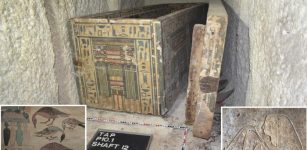 Magnificent Burial Chamber Of Idy, Ancient Egyptian Priestess Of Goddess Hathor Discovered In Asyut
Archaeology | Nov 15, 2024
Magnificent Burial Chamber Of Idy, Ancient Egyptian Priestess Of Goddess Hathor Discovered In Asyut
Archaeology | Nov 15, 2024 -
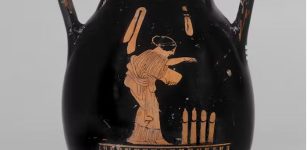 The Long And Satisfying 28,000-Year History Of The Dildo
Featured Stories | Feb 27, 2023
The Long And Satisfying 28,000-Year History Of The Dildo
Featured Stories | Feb 27, 2023 -
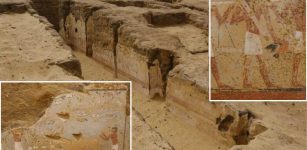 Old Kingdom Mastaba Decorated With Rare Paintings Found In Dahshur Necropolis, Egypt
Archaeology | Mar 22, 2024
Old Kingdom Mastaba Decorated With Rare Paintings Found In Dahshur Necropolis, Egypt
Archaeology | Mar 22, 2024 -
 Five Witchcraft Myths Debunked By An Expert
Featured Stories | Oct 27, 2023
Five Witchcraft Myths Debunked By An Expert
Featured Stories | Oct 27, 2023 -
 Denisovans Or Homo Sapiens: Who Were The First To Settle Permanently On The Tibetan Plateau?
Archaeology | Dec 9, 2021
Denisovans Or Homo Sapiens: Who Were The First To Settle Permanently On The Tibetan Plateau?
Archaeology | Dec 9, 2021 -
 Mysterious Kolob – Does The Sacred Star Of The Mormons Exist?
Featured Stories | Feb 4, 2019
Mysterious Kolob – Does The Sacred Star Of The Mormons Exist?
Featured Stories | Feb 4, 2019 -
 Trung Sisters Of Vietnam: National Heroines That Stood Against Cruel Chinese Occupation Of Their Country
Featured Stories | Apr 29, 2019
Trung Sisters Of Vietnam: National Heroines That Stood Against Cruel Chinese Occupation Of Their Country
Featured Stories | Apr 29, 2019 -
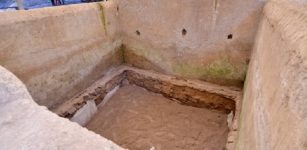 Necropolis of Porta Nola, Pompeii – new discoveries
Civilizations | Aug 30, 2015
Necropolis of Porta Nola, Pompeii – new discoveries
Civilizations | Aug 30, 2015 -
 How The Great Sphinx Gave Thutmose IV Power To Become Pharaoh
Civilizations | Jul 19, 2021
How The Great Sphinx Gave Thutmose IV Power To Become Pharaoh
Civilizations | Jul 19, 2021 -
 Irkalla – Underworld With No Return Ruled By Ereshkigal, Granddaughter Of Enlil And Sister Of Inanna
Featured Stories | Oct 20, 2021
Irkalla – Underworld With No Return Ruled By Ereshkigal, Granddaughter Of Enlil And Sister Of Inanna
Featured Stories | Oct 20, 2021 -
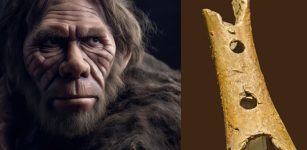 Remarkable Neanderthal Flute Found In Divje Babe Cave Is The World’s Oldest Musical Instrument
Artifacts | Dec 11, 2023
Remarkable Neanderthal Flute Found In Divje Babe Cave Is The World’s Oldest Musical Instrument
Artifacts | Dec 11, 2023 -
 Battle Of Abrittus: Roman Emperor Decius And His Troops Ambushed And Defeated By Invading Goths
Featured Stories | Jul 1, 2019
Battle Of Abrittus: Roman Emperor Decius And His Troops Ambushed And Defeated By Invading Goths
Featured Stories | Jul 1, 2019 -
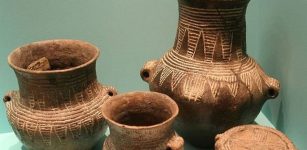 Corded Ware Culture: Skillful Female Artisans Produced Extremely Innovative Pottery 5,000 Years Ago
Archaeology | Mar 30, 2018
Corded Ware Culture: Skillful Female Artisans Produced Extremely Innovative Pottery 5,000 Years Ago
Archaeology | Mar 30, 2018 -
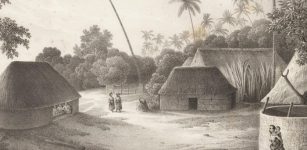 Impact Of European Contact With Pacific Islands Was Devastating – New Study Reveals
Archaeology | Sep 30, 2022
Impact Of European Contact With Pacific Islands Was Devastating – New Study Reveals
Archaeology | Sep 30, 2022 -
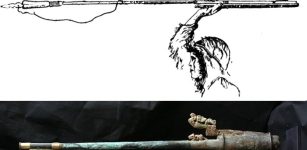 Atlatl Weapon Use By Prehistoric Females Equalized The Division Of Labor While Hunting – Study Shows
Archaeology | Aug 18, 2023
Atlatl Weapon Use By Prehistoric Females Equalized The Division Of Labor While Hunting – Study Shows
Archaeology | Aug 18, 2023 -
 Incredibly Rare Iron Age Wooden Objects Discovered In 2,000-Year-Old Waterlogged Site In The UK
Archaeology | Jan 21, 2023
Incredibly Rare Iron Age Wooden Objects Discovered In 2,000-Year-Old Waterlogged Site In The UK
Archaeology | Jan 21, 2023 -
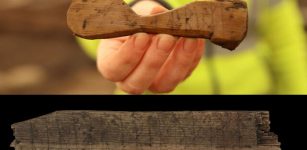 Rare Runic Inscriptions Engraved On Bone And Wood Discovered In Oslo, Norway
Archaeology | Feb 15, 2022
Rare Runic Inscriptions Engraved On Bone And Wood Discovered In Oslo, Norway
Archaeology | Feb 15, 2022 -
 Is Mysterious Prehistoric Jiroft The Legendary Land Of Aratta?
Featured Stories | Aug 20, 2015
Is Mysterious Prehistoric Jiroft The Legendary Land Of Aratta?
Featured Stories | Aug 20, 2015 -
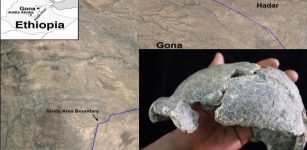 Gona, Ethiopia Discovery: Smallest ‘Homo Erectus’ Cranium In Africa And Stone Tools – Unearthed
Archaeology | Mar 5, 2020
Gona, Ethiopia Discovery: Smallest ‘Homo Erectus’ Cranium In Africa And Stone Tools – Unearthed
Archaeology | Mar 5, 2020


